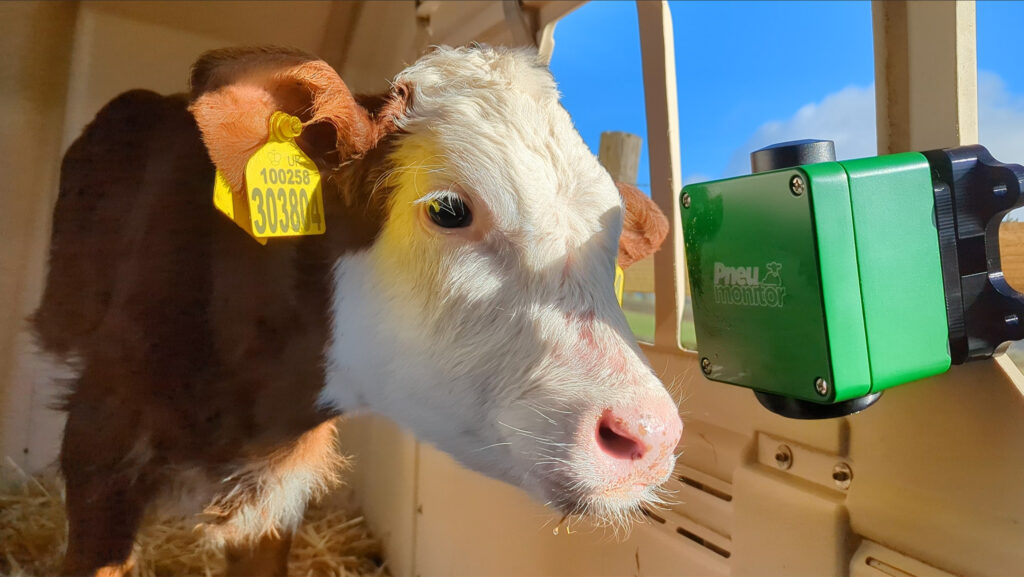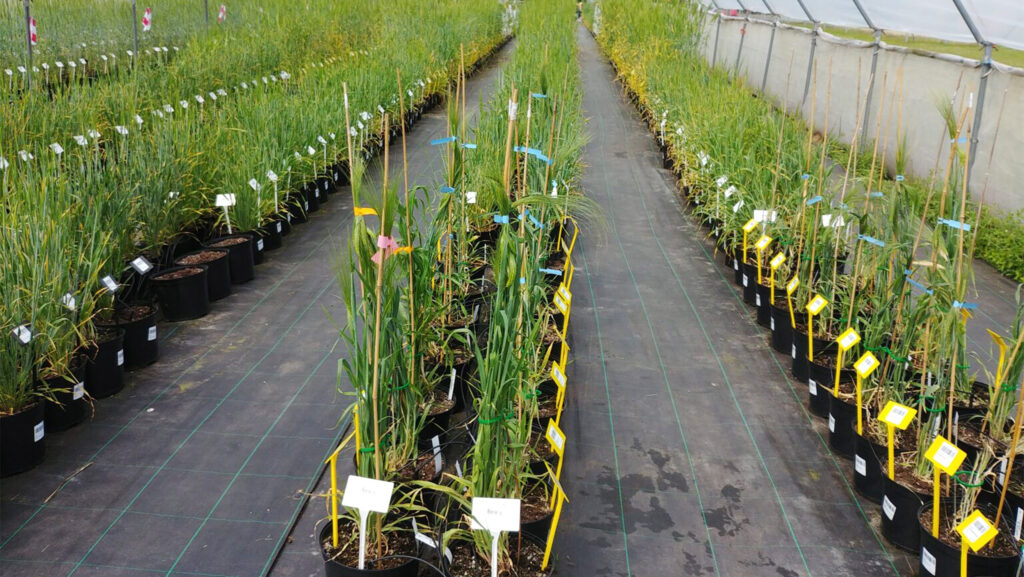NFU Scotland event spotlights farming innovation
 Calf at the Pneumonitor © SRUC
Calf at the Pneumonitor © SRUC Farming has always evolved through innovation – from the first ploughs and seed drills to the mechanisation that transformed efficiency and crop yields.
Today, technology and data are woven into every aspect of farming, enhancing decision-making while complementing the knowledge and experience built over generations.
NFU Scotland president Andrew Connon, speaking at the union’s autumn conference, said Scotland’s farmers and crofters “lead the field in the uptake of science and tech”, supported by world-class research institutes.
See also: Scottish capital grants scheme receives £7m uplift
With the global population expected to reach 9.7bn by 2050, he reminded delegates that “the world will need food – and it will need farmers”.
Despite the challenges ahead, Mr Connon urged members to stay proud and optimistic.
“We have a fantastic industry that leads the world in food production and innovation,” he said. “Be proud to be a farmer, a crofter, or part of that agricultural supply chain.”
Under the theme “Science and Innovation”, the event at the Royal Highland Centre in Ingliston, Edinburgh, on 23 October brought together leading voices from science, policy and food production to explore technologies that will shape farming’s future.
From digital livestock tracking to low-carbon practices, delegates heard how innovation is helping farmers tackle challenges while creating opportunities for growth, efficiency and sustainability.
Herd management tool
Aberdeenshire beef and arable farmer Jilly Duncan Grant, co-founder and chief executive of agri-tech company Herd Advance, is driving Scottish agricultural innovation by blending hands-on farm experience with advanced technology.
For the beef sector, she and co-founder Murdoch Duncan have pioneered Stockman, Herd Advance’s flagship technology designed to improve herd management on their farm and others.
“Stockman is essentially an all-in-one integrated system,” she said, combining hardware and software that gathers real-time data 24/7 from the animal in the field or the pen.
The system monitors cattle as they drink, capturing full body weight, water intake and body temperature at each visit.
The animal’s data is uploaded to a cloud-based portal, providing farmers with performance data and health alerts for each individual animal and across the herd, on their smartphone.
“This system enables farmers to monitor changes in animal performance and health, providing alerts to any variations,” Mrs Duncan Grant explained.
“Early detection supports quicker decision-making or intervention, helping to optimise performance, meet market specifications and improve the wellbeing of the herd.”
Stockman features an integrated selection and drafting gate system within its hardware, allowing farmers to remotely separate and draft animals directly from their smartphone or computer, without the need for manual handling.
“This enables stress-free handling when it comes to drafting cattle out of the pen, or when you’re selecting cattle to go off to market or abattoirs,” said Mrs Duncan Grant.
She describes Stockman as a “co-bot” that enhances, rather than replaces, an experienced farmer’s intuition, providing greater insight for decision-making and giving valuable time back to farmers when they are time-poor.
Smart dairy
Dr Mike Christian, a farm vet and innovation broker for the Digital Dairy Chain at Scotland’s Rural College, is helping drive the next wave of digital transformation in UK dairy farming.
His work connects farmers with ideas, industry partners with the ability to commercialise them, and academic researchers with the expertise and data to prove what works on the ground.
One of his headline projects is Pneumonitor, an innovation that helps farmers prevent pneumonia in calves by tracking the exact conditions they experience.
As Dr Christian explained: “Everybody has an opinion as to whether this calf shed is too wet, too humid, too cold, too hot.
“What is the calf actually experiencing? This new monitor sits at calf height and gives you that data very simply on an app. So you can diagnose the pen, not the calf.”
Developed with support from the Digital Dairy Chain, the in-pen sensor records temperature, humidity, pressure, wind chill and relative volatile organic compounds, alerting farmers when conditions become risky – long before illness sets in.
Beyond Pneumonitor, the Digital Dairy Chain is building a “digital twin of the farm”, integrating multiple data streams – from animal health to weather, feed, and fertility – into a single platform that actually gets much more insight.
This open-source system aims to simplify management and reduce “half a dozen different apps pinging you with alerts”.
The Digital Dairy Chain is also exploring artificial intelligence and machine learning for automated analysis of video from cattle sheds.
This allows tracking of cows and their behaviour, as well as body condition scoring, which Dr Christian says “brings big advantages” by enabling data-driven breeding and productivity decisions while cutting labour and improving animal welfare.
Resilient barley
At the James Hutton Institute near Dundee, the International Barley Hub is developing resilient, high-performing barley for a changing climate.
Professor Tim George, director of the Hub, and his team are tackling the “massive challenge” of producing more food on less land amid increasing climate variability.
Using long-term models, they predict that by 2050 drought frequency could double in many parts of Scotland to one year in every five.
The Hub is developing climate-resilient cultivars suited to reduced-input, regenerative systems and “specific-to-place and value chains”.
The institute, the UK’s centre for barley genome editing, is using precision breeding to deliver new varieties in five to 10 years.
Prof George believes Scotland could lift its gene-editing ban to align with England, if EU legislation is revised.
He suggested that while nitrogen-fixing cereals may be out of reach, enhancing crop-soil microbe interactions could improve nitrogen efficiency.
Beyond crop development, the team is exploring agronomy, comparing regenerative and conventional farming systems and their carbon footprints.

© Hutton Institute
Farm audit simplification
Delegates also learned about efforts to tackle the burden of multiple farm audits.
Tom Porter, a young farmer and entrepreneur from Carnoustie, has created AgriAudit, a mobile app and web platform designed to make audits “simple, stress-free and efficient”.
Frustrated by the sheer volume of forms, files, folders and duplication, he developed a system to help farmers streamline the audit process.
AgriAudit centralises more than 3,000 repeated requirements across 40 UK schemes, letting users upload files once, and they are automatically assigned to the relevant standards.
Mr Porter said the platform reduced stress, saved time and showed farmers “exactly what’s complete and what’s missing”, making audits far more manageable.
For more information visit agriaudit.co.uk.
Livestock database sets the standard, say farmers
Scotland’s pioneering livestock traceability system, ScotEID, is being hailed by farmers as a model of efficiency and value – leaving England “lagging behind” with an outdated, costly alternative.
ScotEID is a national, real-time database that records the legally required data of births, deaths and movements of cattle, sheep, and pigs in Scotland – but also supports voluntary traceability for other species such as ferrets and pigeons.
“Scotland decided to create its own database because it was paying Defra for having a share within the British Cattle Movement Service [BCMS] and the Cattle Tracing System,” said Robert Neill, a farmer from the Scottish Borders and vice-president of NFU Scotland.
“In my opinion, [BCMS] is not fit for purpose anymore. Scotland has created this database on a very small budget and it’s working really well.”
Mr Neill, who also chairs the ScotEID stakeholder group, said the system fulfils the goals he outlined in his 2013 Nuffield Scholarship report on cattle traceability.
“Number one, we need a real-time database. We’ve got that,” he said. “Working in history is no good for man nor beast. As soon as you hit that send button, it’s there.”
The next step, he said, was making electronic identification (EID) mandatory for cattle using ultra-high frequency (UHF) tags.
“England is going LF [low frequency]. Scotland is favouring UHF. When we get EID mandatory, we get rid of paper passports. That’s a huge burden and cost to Westminster and Holyrood alike.”
Farmers say the UHF system will improve safety and efficiency. “Health and safety wise, it’s a no-brainer,” said Hugh Fraser, chairman of the NFUS livestock committee.
“At the mart, animals are stressed and flighty – staff shouldn’t have to go in and read tags. With UHF, you can scan 20 cattle on a lorry or read them as they pass down a 10ft race.”
In a recent letter to the UK Public Accounts Committee, Martin Kennedy, the ScotEID board chairman and a former NFUS president, said the voluntary system “costs under £2.5m a year” and already managed millions of animal records.
“Rather than holding their progress back, Scotland is waiting for England and Wales to catch up,” he wrote.
With its success grounded in collaboration and real-world testing, Mr Kennedy said: “ScotEID proves what’s achievable when industry leads with government support.”
